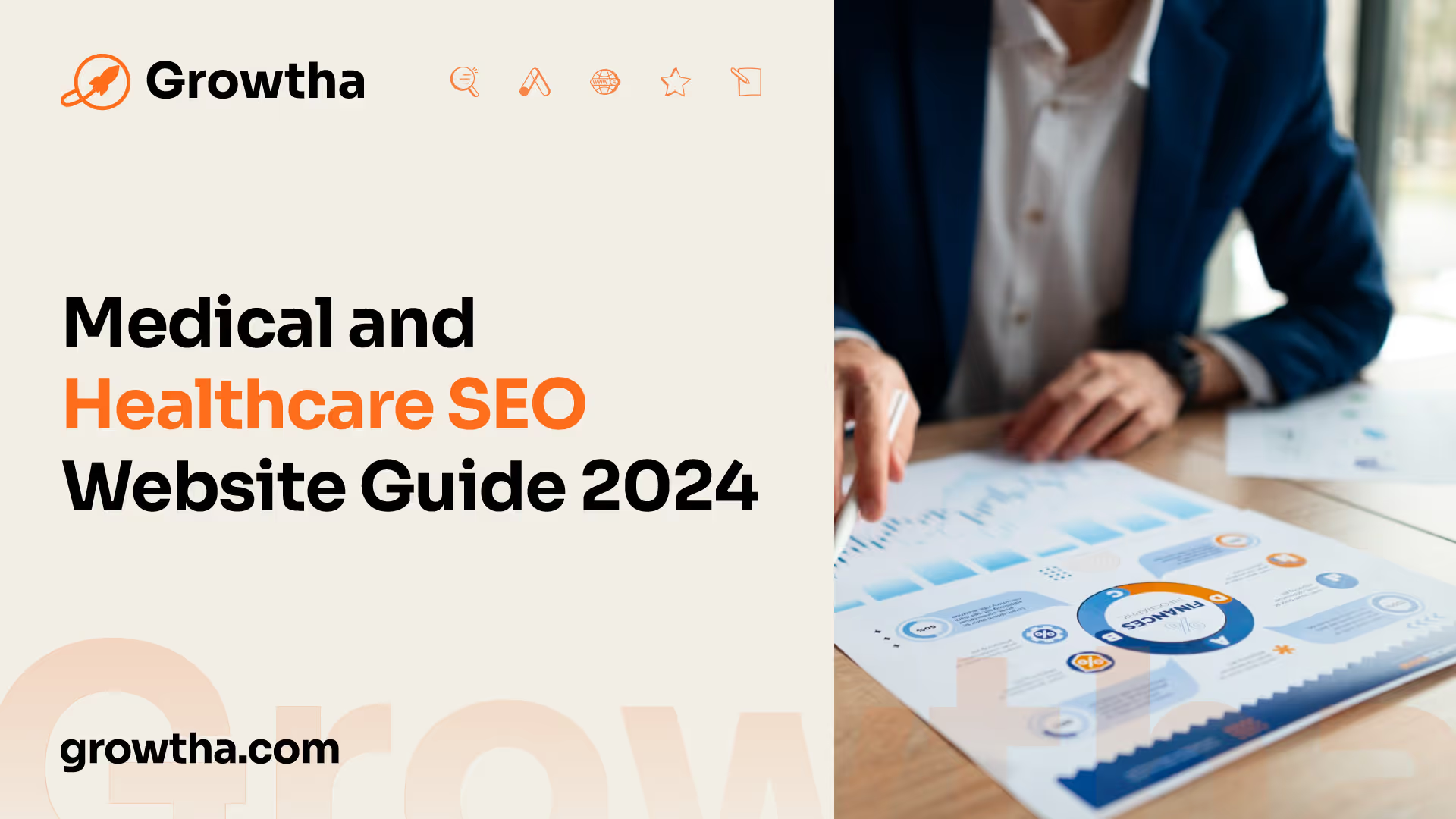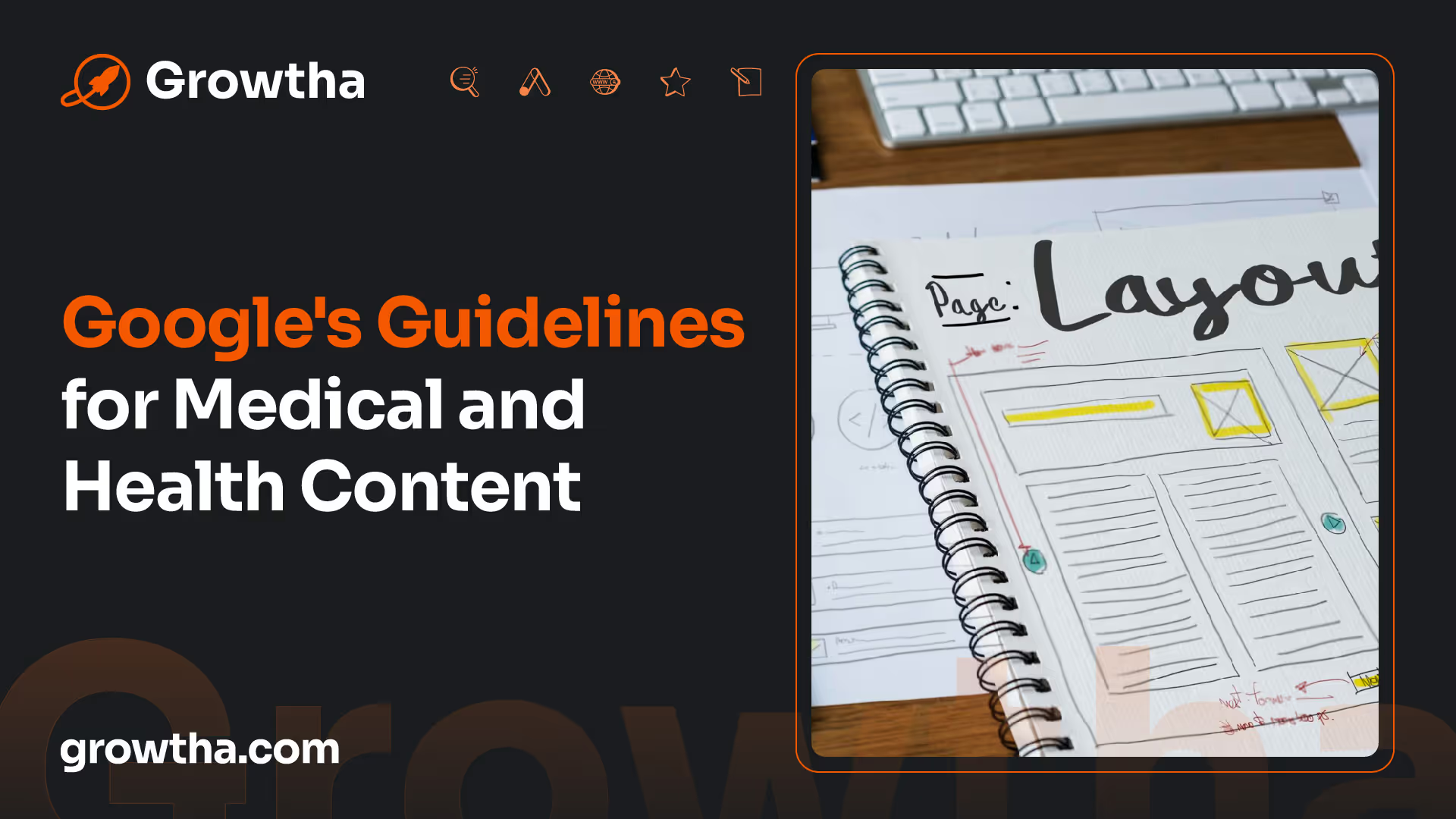Medical and Healthcare SEO Website Guide 2024
In the digital age, having a strong online presence is crucial for healthcare providers looking to expand their reach and engage with a broader audience of patients.


Medical and Healthcare SEO Website Guide 2024
The Importance of Medical and Healthcare SEO
In the digital age, having a strong online presence is crucial for healthcare providers looking to expand their reach and engage with a broader audience of patients. This is where medical and healthcare SEO (Search Engine Optimization) plays a pivotal role. By understanding medical SEO and leveraging effective healthcare marketing strategies, healthcare providers can enhance their online visibility and attract more potential patients.
Understanding Medical SEO
Medical SEO involves optimizing a healthcare website to improve its visibility in search engine results. When individuals search for medical information or healthcare services online, search engines like Google aim to deliver the most relevant and trustworthy results. Therefore, understanding and implementing medical SEO best practices is essential to ensure that healthcare websites rank higher in search engine results pages (SERPs).
Google emphasizes the importance of medical and health content being produced by authoritative sources, highlighting the significance of expertise, authoritativeness, and trustworthiness (E-A-T) signals [1]. By establishing expertise and trustworthiness through high-quality content, medical websites can strengthen their online reputation and attract more patients.
Benefits of Healthcare Marketing
Effective healthcare marketing, including medical SEO, offers numerous benefits for healthcare providers. By implementing good SEO practices, medical websites can improve their search engine rankings, driving increased website traffic. This increased visibility provides more opportunities for potential patients to access content, learn about medical services, and schedule appointments.
A well-optimized healthcare website can also enhance the overall patient experience. By providing informative and engaging content, patients can easily find the information they need, leading to improved patient satisfaction. Additionally, healthcare marketing strategies that focus on local SEO can help healthcare providers attract patients from their specific geographical area, increasing the chances of converting website visitors into actual patients.
Ultimately, medical and healthcare SEO is an essential tool for healthcare providers to establish a strong online presence, reach a wider audience, and build a reputable brand image. By investing in effective healthcare marketing strategies and staying up-to-date with the latest SEO trends, healthcare providers can position themselves for success in the digital landscape of 2024 and beyond.

Google's Guidelines for Medical and Health Content
When it comes to medical and health-related content, Google has specific guidelines in place to ensure the quality and reliability of information. These guidelines emphasize the importance of expertise, authoritativeness, and trustworthiness (E-A-T) signals, as well as the involvement of professionals in content creation.
Expertise, Authoritativeness, and Trustworthiness (E-A-T)
Google places a strong emphasis on E-A-T signals when it comes to medical and health content. This means that websites providing such content should be produced by authoritative sources and demonstrate expertise in the field. The goal is to ensure that users can trust the information they find online.
To enhance the E-A-T of your medical website, it's important to showcase the qualifications and expertise of the individuals responsible for creating the content. This can include doctors, healthcare professionals, and other experts in the field. By highlighting the credentials and experience of these professionals, you can build trust with your audience and establish your website as a reliable source of information.
Content Creation by Professionals
In line with the E-A-T guidelines, Google recommends that medical and health content be created by appropriate professionals, such as doctors or healthcare experts. This ensures that the information provided is accurate, reliable, and up-to-date.
When professionals are involved in content creation, it adds credibility to your website and increases the trustworthiness of the information you provide. It's important to clearly attribute the content to the professionals who contributed to its creation, whether through author bylines or author profiles. This helps users understand the expertise behind the content and builds trust in your website as a reliable source of medical information.
By adhering to Google's guidelines regarding E-A-T signals and involving professionals in content creation, you can enhance the quality and credibility of your medical and health-related website. This, in turn, can improve your website's visibility, attract more users, and establish your online reputation as a trusted resource in the healthcare industry.
Strategies for Effective Healthcare Marketing
In the competitive landscape of healthcare marketing, implementing effective strategies is essential to stand out and attract patients. This section explores three key strategies: creating informative and engaging content, optimizing website load time, and voice search optimization.

Creating Informative and Engaging Content
Informative and engaging content plays a crucial role in healthcare marketing. Patients are increasingly turning to the internet for medical information, making it essential for healthcare websites to provide valuable and reliable content. Google's algorithms prioritize high-quality content, and websites focused on medical and healthcare SEO should ensure that their content helps users understand health topics [1].
To create informative content, healthcare providers should consider their target audience's needs and questions. Addressing common health concerns, explaining medical procedures, and providing accurate information can help establish trust and authority. Incorporating visuals, such as infographics or videos, can further enhance engagement and understanding.
Optimizing Website Load Time
Website load time is a crucial factor for both user experience and search engine optimization. Slow-loading websites can lead to high bounce rates and decreased patient satisfaction. Additionally, Google considers website speed as a ranking factor, making it essential to optimize load times.
To improve website load time, healthcare providers should focus on factors such as image optimization, browser caching, and minimizing unnecessary code. Compressing images, leveraging browser caching, and reducing the size of CSS and JavaScript files can help accelerate load times. Regular performance monitoring and testing can identify areas for improvement.
Voice Search Optimization
With the rise of smart devices and virtual assistants, voice search optimization is becoming increasingly important in healthcare marketing. Patients are embracing voice search functionality for its convenience, particularly when accessing healthcare information. It is reported that 71% of respondents prefer using their voice assistant to search for something rather than typing their queries [2].
To optimize for voice search, healthcare professionals should adapt their content and SEO strategies to cater to voice queries. This involves using long-tail keywords and phrases that mirror natural speech patterns. Understanding the intent behind voice searches and providing concise, conversational answers can help improve visibility in voice search results [3].
By implementing these strategies, healthcare providers can enhance their marketing efforts and effectively reach their target audience. Creating informative and engaging content, optimizing website load time, and adapting to voice search trends are key steps towards improving visibility and attracting patients in the ever-evolving landscape of healthcare marketing.
SEO Trends in Healthcare Marketing
To stay ahead in the ever-evolving landscape of healthcare marketing, it's crucial to keep up with the latest SEO trends. In 2024, several trends are shaping the way medical and healthcare websites optimize their online presence. Let's explore some of these key trends:
Local SEO for Hospitals
Local SEO for hospital providers remains an essential trend in 2024, emphasizing the significance of optimizing online visibility for local searches and targeting patients in the hospital's geographical area. This trend underscores the importance of appearing in local search results for healthcare services, appointments, and information. By implementing local SEO strategies, hospitals can increase their online presence in the local community and attract potential patients in need of their services. This includes optimizing Google My Business profiles, managing online reviews, and ensuring accurate and consistent information across local directories and listings.
AI and Web Accessibility
Artificial Intelligence (AI) is expected to have a transformative impact on web accessibility, indicating the growing importance of incorporating AI technologies in web design to enhance accessibility for users with disabilities or impairments. AI-based solutions can improve website usability and provide accessibility features such as screen reader compatibility, voice commands, and alternative text for images. By prioritizing web accessibility, healthcare websites can ensure that all individuals, regardless of their abilities, can access and navigate their online content effectively.
FAQ Pages for Patient Information
Creating a detailed Frequently Asked Questions (FAQ) page can help healthcare websites provide valuable information to patients and improve their search engine rankings. By addressing common patient questions in a clear and concise manner, healthcare providers can enhance user experience and boost SEO performance. FAQ pages not only serve as a resource for patients seeking answers but also provide search engines with structured content that matches user queries. This helps improve the visibility and relevance of the website in search results.
Schema Markup for Enhanced Visibility
Implementing schema markup is essential for medical and healthcare websites to make it easier for search engines to understand and display relevant website information in search results. Schema markup uses structured data to provide additional context and metadata about the content on a webpage. For medical practices, implementing schema markup can enhance the visibility of information such as patient reviews, services offered, contact details, and more. By including schema markup, healthcare websites can increase their chances of appearing in rich snippets, knowledge panels, and other enhanced search results, which can drive more organic traffic to their site.
Incorporating these SEO trends into healthcare marketing strategies can help medical and healthcare websites improve their online visibility, reach their target audience, and provide a better user experience. By staying abreast of the latest trends, healthcare organizations can position themselves for success in the digital landscape of 2024 and beyond.
On-Page SEO Techniques for Medical Websites
To optimize the visibility and search engine rankings of medical and healthcare websites, implementing effective on-page SEO techniques is essential. By strategically optimizing title tags, meta descriptions, and incorporating relevant keywords, as well as creating high-quality content, medical websites can attract more organic traffic and improve their online presence.
Optimizing Title Tags and Meta Descriptions
Title tags and meta descriptions play a crucial role in conveying the relevance and purpose of a webpage to search engines and users. Including targeted keywords and providing a concise and informative summary of the page's content can improve click-through rates and search engine rankings.
When optimizing title tags and meta descriptions for medical websites, it's important to:
- Include relevant keywords: Incorporate keywords related to medical services, treatments, and specialties to attract the right audience.
- Keep it concise: Ensure that title tags are within 50-60 characters and meta descriptions within 150-160 characters to display properly in search engine results.
- Provide value: Clearly communicate the unique value proposition or key information that the webpage offers to entice users to click.
Incorporating Relevant Keywords
Incorporating relevant keywords throughout the content of medical websites is crucial for improving search engine visibility. Keyword optimization helps search engines understand the relevance of the webpage to specific search queries. When incorporating keywords, it's important to:
- Conduct thorough keyword research: Identify keywords that are relevant to the medical services, treatments, or information provided on the website.
- Use keywords strategically: Incorporate keywords naturally within headings, subheadings, and throughout the content while maintaining readability and avoiding keyword stuffing.
- Optimize images: Use descriptive alt text and file names for images on the website to provide context to search engines and improve accessibility.
Creating High-Quality Content
Creating high-quality, relevant, and informative content is a cornerstone of effective medical SEO. By publishing content that addresses common healthcare concerns, treatments, and procedures, medical websites can establish themselves as authoritative sources and improve their search engine rankings.
When creating content for medical websites, it's important to:
- Focus on relevance and expertise: Ensure that the content is aligned with the target audience's needs and interests while showcasing the expertise of the healthcare professionals involved.
- Provide accurate information: Ensure that the content is factually accurate and up to date, citing reputable sources as necessary.
- Optimize for readability: Use clear and concise language, break up content with headings and subheadings, and incorporate bullet points and lists to enhance readability.
- Interlink relevant content: Link related pages and articles together to create a comprehensive web of information and improve user navigation on the website.
By optimizing title tags and meta descriptions, incorporating relevant keywords, and creating high-quality content, medical websites can enhance their search engine visibility, attract the right audience, and establish themselves as authoritative sources in the healthcare industry. These on-page SEO techniques are essential for driving organic traffic and improving the overall performance of medical websites.
Off-Page Optimization for Medical SEO
To maximize the search engine optimization (SEO) efforts of medical websites, it is essential to focus on off-page optimization strategies. These strategies involve activities outside of the website itself, such as building backlinks from reputable sources and leveraging industry publications and directories.
Building Backlinks from Reputable Sources
Building backlinks from reputable and relevant websites within the healthcare industry can significantly impact the SEO performance of medical websites. By earning backlinks from sources such as medical journals, industry publications, and local directories, healthcare websites can enhance their online credibility, domain authority, and search engine rankings, ultimately driving more organic traffic to their site [4].
Backlinks from reputable sources act as endorsements for the quality and reliability of the medical website's content. Search engines consider these backlinks as a signal of trust and authority, which can positively influence the website's ranking in search results. It is important to prioritize obtaining backlinks from authoritative websites within the healthcare industry to strengthen the website's online presence.
Leveraging Industry Publications and Directories
Industry publications and directories play a crucial role in off-page optimization for medical SEO. By obtaining backlinks from reputable sources within the healthcare industry, medical websites can enhance their online visibility, credibility, and search engine rankings [3]. These publications and directories act as trusted resources for patients and professionals seeking reliable healthcare information.
By being featured in industry publications, medical websites can gain exposure to a wider audience and establish themselves as authoritative sources of information. This can lead to an increase in website traffic, brand recognition, and patient trust.
Furthermore, being listed in relevant directories specific to the medical field can improve the website's local SEO efforts. Local directories such as medical associations, healthcare organizations, and community healthcare directories can help medical websites target local patients and improve their visibility in local search results.
By utilizing industry publications and directories, medical websites can benefit from the credibility and authority associated with these sources, ultimately enhancing their online presence and search engine rankings.
Off-page optimization is a crucial aspect of medical SEO that should not be overlooked. By building backlinks from reputable sources and leveraging industry publications and directories, medical websites can strengthen their online credibility, increase their domain authority, and ultimately improve their search engine rankings. These strategies contribute to a comprehensive SEO approach that drives organic traffic and promotes the visibility and success of medical websites.
Google's Algorithm Update and Medical Websites
Google's algorithm updates play a significant role in determining the visibility and ranking of medical websites. Staying up to date with these updates is crucial for healthcare marketers and webmasters to ensure their websites adhere to the latest SEO requirements. In this section, we will explore key aspects of Google's algorithm update that impact medical websites: Core Web Vitals and User Experience, optimizing meta titles and descriptions, mobile-friendly websites, and authority and trustworthiness.
Core Web Vitals and User Experience
Google's Page Experience Update now considers Core Web Vitals, which include metrics such as Largest Contentful Paint (LCP), First Input Delay (FID), and Cumulative Layout Shift (CLS). These metrics have become crucial for medical and healthcare websites to focus on in order to improve user experience and SEO rankings [5].
By optimizing web pages to improve LCP (the time it takes for the largest content element to load), reducing FID (the delay between a user's interaction and the website's response), and minimizing CLS (the amount of unexpected layout shifts), medical websites can enhance the overall user experience. This, in turn, can positively impact search engine rankings and increase organic traffic.
Optimizing Meta Titles and Descriptions
The click-through rate (CTR) of search results can significantly impact a website's ranking on Google. Therefore, it is essential for medical websites to focus on optimizing their meta titles and descriptions to entice users to click through to their site [5].
Crafting compelling and relevant meta titles and descriptions that accurately represent the content of each page can improve CTR. Including relevant keywords and providing a clear and concise description of the page's content can help attract users and increase the likelihood of clicks from search engine result pages (SERPs).
Mobile-Friendly Websites
Mobile-friendliness of a medical website is a critical aspect for Google's ranking criteria. With the increasing use of mobile devices for internet browsing, it is imperative for healthcare websites to ensure they are optimized for mobile devices to maintain high search engine visibility [5].
Google's algorithm gives preference to websites that provide a seamless and user-friendly experience on mobile devices. Responsive design, fast-loading mobile pages, and easy navigation are key factors to consider when optimizing a medical website for mobile devices. Ensuring that all content is readily accessible and readable on smaller screens is essential for maintaining a strong online presence.
Authority and Trustworthiness
The authority and trustworthiness of a medical website are crucial elements impacting its SEO performance. Google values authoritative content, credible sources, and backlinks from reputable sites when determining the trustworthiness and relevance of a website [5].
To enhance authority and trustworthiness, medical websites should focus on creating high-quality, well-researched, and accurate content. Citing reputable sources, including medical professionals, and earning backlinks from authoritative websites within the healthcare industry can significantly boost a website's credibility.
By prioritizing Core Web Vitals and user experience, optimizing meta titles and descriptions, ensuring mobile-friendliness, and establishing authority and trustworthiness, medical websites can align themselves with Google's algorithm update. Implementing these strategies can improve search engine visibility, increase organic traffic, and ultimately contribute to the success of healthcare marketing efforts.
References
[1]: https://www.searchenginejournal.com/google-broad-core-updates-ranking-loss/316115/
[2]: https://colorwhistle.com/healthcare-medical-seo-guide/
[3]: https://thebravelabs.com/blog/6-most-important-seo-trends-for-hospitals-in-2024/
[4]: https://www.sixthcitymarketing.com/healthcare-seo/
[5]: https://www.medicalwebexperts.com/blog/what-googles-2021-algorithm-update-means-for-medical-websites-the-7-metrics-you-need-to-know/







